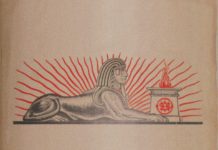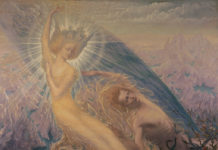Discoveries around Geheime Figuren der Rosenkreuzer or “Secret Symbols of the Rosicrucians”
In this blog post Christine Eike, a regular here at Pansophers, provides her insightful scholarship once again to Roscrucian source documents. In this post she analyzes the Secret Symbols of the Rosicrucians to reveal its origins and translates for the first time several sections and opinions from German scholars which have not yet seen the full light of day in the English speaking world. This is a must read post!
Part one: The core of the book is the school to the Holy Ghost and the Living Word which has become flesh
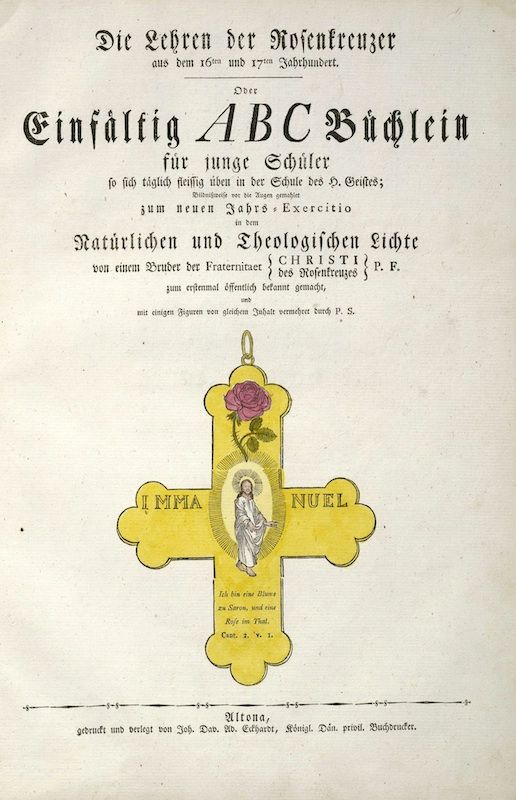 What is now known as Secret Symbols or Geheime Figuren of the Rosicrucians is one of the finest and most symbolic books that Rosicrucians have ever produced. It was printed in three booklets in the years 1785-88 in Altona, Germany (then Denmark).
What is now known as Secret Symbols or Geheime Figuren of the Rosicrucians is one of the finest and most symbolic books that Rosicrucians have ever produced. It was printed in three booklets in the years 1785-88 in Altona, Germany (then Denmark).
Many people use the exceptional emblems for contemplation and meditation. They must be understood and resonate with our soul to be able to get to the depth of them. An intellectual understanding is not enough.
A German original in three parts, coloured, can be read and uploaded today from the Internet[1]. The full German title is : Geheime Figuren der Rosenkreuzer, aus dem 16ten und 17ten Jahrhundert. Aus einem alten Mscpt zum erstenmal ans Licht gestellt. Erstes (– drittes Heft). Altona 1785-1788. Gedruckt und verlegt von J. D. A. Eckhardt.
Part of the book was translated by Franz Hartmann in 1888 and in the early 20th century Harvey Spencer Lewis also had parts of the book translated. There are several English translations of the whole book to be found on the Internet today.
If you compare the German version of the web with the existing English editions, it becomes clear that the sequence of the emblems does not match at all. But also German versions differ.
It has been said that the sequence of emblems of the Rosicrucian symbols are helter-skelter on purpose and published thus by the Altona publisher to confuse the reader and cover up their real purpose. The sequence therefore, does not provide a logical context and meaning. The one who could figure out the correct sequence would actually experience some kind of initiation in the inner doctrine of the Rosicrucian tradition in the 18th century.
Now, however, there has been a new German edition at Buchhandlung und Verlag Engel, Stuttgart[2]. In this new edition one follows for the first time the editing plan that was announced in 1766 by Friedrich Christian Ritter, a bookseller in Hamburg. Here were planned 40 illuminated copper plates. They are described in detail so that they can be identified. This should be published in 1767 and as one book. The book should be printed in a hundred copies, and the plates should be based on “the most genuine, most accurate and never before so fully-seen original copy”.
Well, Ritter’s plan did not materialize, but the Geheime Figuren was printed almost 20 years afterwards and in three booklets. There was also only just one copper plate, the rest being woodcuts. And a great deal had been added and some had been left out. The new German version of today manages to follow the original plan from 1766, mostly. But they could not assign ten emblems from Ritter’s original plan, on the other hand they have added nine emblems and some longer texts from the Secret Symbols.
The original title
One thing is certainly clear: The original planned title for the book was not Geheime Figuren (Secret symbols) der Rosenkreuzer aus dem 16. und 17. Jahrhundert, but Die Lehren der Rosenkreuzeraus dem 16ten und 17ten Jahrhundert … (The teachings of the Rosicrucians from the 16th and 17th century …) And it was an ABC book for young pupils of the school of the Holy Ghost. (See picture at the start of this article).
But then something interesting happens. Table 2 of Ritter’s plan could not be identified.  However, table three is this: (see picture on the right).
However, table three is this: (see picture on the right).
And then something even more interesting: The next tables or emblems from Ritter’s plan accurately follow the order of what is called the D.O.M.A. or Physica, metasphysica, hyperphysica manuscript, from its page 3 to its page 28. Thus, the sequence becomes both understandable and logical.
In fact, on the title page of the Altona edition, it says that the Geheime Figuren are published for the first time from an old manuscript, and on the next page it is stated that P. S. has added several plates and similar content to this old manuscript.
The D.O.M.A manuscript
Already in 1938, Manly P. Hall claimed that this old manuscript, mentioned here in the title of the Geheime Figuren, had to be D.O.M.A., and wrote a very beautifully illustrated book about this. It is called Codex Rosae Crucis, D.O.M.A. and first appeared in 1938 and in a new edition in 1971[3].
This D.O.M.A. manuscript Manly P. Hall acquired in 1935 in London, but it is written in German (and Latin). He had it translated into English for his book, which contains both the German original and the English translation. He has also examined a manuscript that ended in America, in Philadelphia. Its owner was Dr. Julius Sachse, who in turn believed that it belonged to the German pietist Johannes Kelpius, who arrived in Philadelphia in 1694. It has therefore always been referred to as the Kelpius manuscript.
Manley Hall, on the other hand, believed that this is incorrect – and would rather refer to the Philadelphia manuscript as the Sachse manuscript. Since it was impossible for Hall to determine how and when it may have ended in America. It is nonetheless written in German and must be of German origin.
There are several manuscripts in Europe that M. P. Hall knew about, all manuscripts with the same content. He believed they were all from the 18th century. In this digitalized world in which we live, I have at least discovered three manuscripts which M. P. Hall did not know about: two in Herzog August Bibliothek in Wolfenbüttel, and one in the Staats- und Universitätsbibliothek Hamburg. They are essentially identical to the manuscript that Hall has acquired.
Manly P. Hall clearly states that there are Rosicrucian references in the D.O.M.A. manuscript, but was not entirely sure if this was a manuscript written solely by and for Rosenkorsere, since the title page of the manuscript does not explicitly mention it, only that it is a small “simple” ABC book for the young students who daily practice the school of the Holy Spirit. However, here Manly P. Hall was wrong. The title pages from two of the manuscripts that are now digitalized say something else: one from Wolfenbüttel [4] and the other one from Hamburg.
 In the manuscript from Hamburg[5], which is also dated to 1700-1730 by the Staats- und Universitätsbibliotek it is expressly said that it is “the teachings of the Rosicrucian brothers, for young students who will daily practice in the school of the Holy Spirit, simply and with pictures painted to practice with. In the natural and theological light by a brother of the Rosy Cross”. The rest of the title: Physica, Metaphysica, etc. can be found on the next page. And the rest of the content is exactly the same as in M. P. Halls D.O.M.A. manusscript.
In the manuscript from Hamburg[5], which is also dated to 1700-1730 by the Staats- und Universitätsbibliotek it is expressly said that it is “the teachings of the Rosicrucian brothers, for young students who will daily practice in the school of the Holy Spirit, simply and with pictures painted to practice with. In the natural and theological light by a brother of the Rosy Cross”. The rest of the title: Physica, Metaphysica, etc. can be found on the next page. And the rest of the content is exactly the same as in M. P. Halls D.O.M.A. manusscript.
Many references to the Rosicrucians
There are many references to the Rosicrucians on the plates as well. On the emblem “The Heavenly and Earthly Eve” for instance (see plate 23 of the D.O.M.A. manuscript) one can read Rosicrucians come (Rosae Crucis Venite), as well as a reference to the Fama: Under the shadow of thy wing, and May you see the college of the Holy Spirit (Videamini Collegium ad Spiritum Sanctum).
Or on Plate 13: The cabalistic figure, the real reason for the wondrous number of God 1234 we can read both the letters R. and C besides a circle divided in four parts and besides another circle divided into four parts: The enclosed Rosy Cross about which the world knows to speak, apparent to our eyes, evident, and the secret of all secrets in Heaven and on Earth. On plate 14: The Secret wonder-Number 1.2.3.4. the central figure is what the Rosy Cross according to philosophy and theology. The secret hidden Rosy Cross which the world does not know, and still has much to say about .
On plate 16 and 17 a circle divided into four parts with the initial letters for the father, the son and the Holy Ghost + for Jesus Christ and Man surrounding it, is called the heavenly supernatural Rosy Cross. Its counterpart, the temporal natural Rosy Cross, is a circle divided into four parts with the initials for the four elements around it. Finally on the last plate we learn that the divine and earthly nature reconciled and equilibrated on the scales of the R.C. result in the perfect adept, the true magus.
Thus, it is clear that the core of what is now titled Geheime Figuren or Secret Symbols (which is actually the teachings of the Rosy Cross) are these “D.O.M.A.” manuscripts, discovered by Manly P. Hall and now also in several digitalized copies. If you really want to immerse yourself in what was taught in the “Rosicrucian School of the Holy Spirit” or Collegium ad Spiritum Sanctum, you should examine these plates or emblems further.
Now where does this D.O.M.A.[6] manuscript stem from? Which is, as we have seen, considered as a Rosicrucian manuscript by its creators? Rafael T. Prinke has a highly interested article: LAMPADO TRADO. From the Fama Fraternitatis to the Golden Dawn. First published in the Hermetic Journal, 30 (1985) but later to be found on the alchemy website[7]. In the University Library in Wroclaw (Breslau), the capital of Silesia, he found a manuscript copy of the D.O.M.A. text bound together with a manuscript of The Magical Calendar. It was mentioned by Will Erich Peuckert who thought it dated from the second half of the 17th century on the basis of paleographic analysis. Now Prinke found quite a few mistakes in the Sachse manuscript and the other manuscripts mentioned by Hall. But not in the Wroclaw Ms .
He therefore thinks it is the original or a very early copy into which these mistakes had not crept in. He says I suggest that the Wroclaw Ms of D.O.M.A. is the original of all the other texts and was produced in the second half of the 17th century (most probably around 1650).
And Prinke concludes: It can therefore be concluded that the D.O.M.A. text was a descendant of all the principal influences which, taken together, constitute what is now called “Rosicrucianism”, and that the main line of descent goes back to the circle of Jacob Boehme’s students. It can further be suggested that the text was produced in Silesia around 1650 by a group connected with Abraham von Franckenberg and other “pansophists”. Most probably it was not allowed to make many copies of it at first, though it may be supposed that Johannes Kelpius took one of them to America in 1694, a later copy of which may have been the Sachse Ms.
The original Silesian group (Frankenber’s “Pansophic Circle”) made itself known again through the work of Sigmund Richter (Sincerus Renatus) and then spread all over Germany, Austria, Poland, Russia and other countries as the well known Order of the Golden and Rosy Cross. This coincided with the appearance of more copies of the D.O.M.A. in wide circulation from France to Russia, leading to its final publication in Altona in 1785 and 1788.
What does this school of the Holy Ghost teach?
Now what does this school of the Holy Ghost – or the Collegium ad Spiritum Sanctum (the College to the Holy Ghost) as it is named on plate 23 – teach? It is quite obvious that this is not a simple beginner’s book for us. This was another time and another culture. But I presume there were some nuts to crack for the young pupils back then too. Probably they were supposed to study and contemplate each emblem for quite some time. One plate says explicitly If you want to be a philosopher, let patience flow into you. Some of these plates are very intricate and copious, so one could probably write a whole book about each of them. To understand them with our intellect is not enough either, they must be experienced, made part of ourselves to be understood. So I advise everyone to study them yourself, at least some of the major ones, they are maybe worthwhile to spend some time with, even for our world. For instance: Plate 23 The heavenly and earthly Eve, mother of all creatures in Heaven and on Earth. Virgin Wisdom is loaded with meaning.
But just some clues one the whole. There is undoubtedly a lot of Cabbala there, as the titles and texts numerously imply. One plate has the title: Devine Figure of theosophy: cabala: not only magic and philosophy, but also chemistry. There is much alchemy. The motto. O Man know God and thyself and you shall not want in Heaven or on Earth is repeated frequently. So this book leads to an understanding of eternity and time, an understanding of the invisible divine nature and the visible created nature. And the means that are offered to reach this are numbers and geometry.
Numbers are important
The numbers that are very important are four and three. Three, the trinity, is often understood as the spiritual principle of creation, four is the manifestation of this trinity in matter. Three is also sulpher, mercury and salt in alchemy. Four are the four elements. But also the four letters of the divine name.
Three plus four leads to the septenary mysteries. The geometrical figures that prevail are the triangle, the circle, the circle divided into four parts and the hexagram. Now there is something interesting there. The sum of the angles of an equilateral triangle results in half a circle. Just one angle more and the sum of the angels results in a full circle, the ONE. This is meant by the circles devided into four parts – which are often called the Rosy Cross. But also the sum of the angles of a hexagram make a full circle, a wholeness. The gemetrical figure that combines the upper and the lower word.
The Tetractys
At the heart of it all stands the tetractys. The Greek word means the number four and it has been peculiarly applied to a symbol of the Pythagoreans, which is composed of ten dots arranged in a triangular form of four rows. Each of the sides of the triangle consists of four points, and the whole number of ten is made up by the summation of the first four figures, 1 + 2 + 3 +4= 10. A prayer of the Pythagoreans shows the importance of the Tetractys: Bless us, divine number, thou who generated gods and men! O holy, holy Tetractys, thou that containest the root and source of the eternally flowing creation! For the divine number begins with the profound, pure unity until it comes to the holy four; then it begets the mother of all, the all-comprising, all-bounding, the first-born, the never-swerving, the never-tiring holy ten, the keyholder of all. The tetractys is associated with creation, the planetary motions, the tetragrammaton, music and Cabbala – amongst other things. It is quite clear from one of the plates that this tetractys plays a central part.

In this again remind of Jacob Boehmes well-known diagram, which leads from the four letters I H V H to the five as, increased with the Hebrew letter Shin at the bottom, which means Jesus.

Jacob Boehme writes about this, his Tetractys: Because we human beings have only one thing that points to God, and this is for all, everyone has it inwards, that is the dear name of God, his letters are the flames of Love, which he has opened in us from his heart in the precious name Jesus. Read these let- ters in your heart and mind, thus you will have enough books.
The D.O.M.A. manuscripts open by telling us I know, I want, I can do, I love, I glory in, I delight in. I seek, I also wish for nothing in Heaven and earth except the living word alone which has become flesh in Jesus Christ the crucified. The WORD appears over and over again in the emblems. When one comes to the final plate there are three circles divided into four: I.C. (Jesus Christ) Jehova, Nature and the bodily and incomprehensible Sun. But in the middle there is written Verbum the Word, symbolized by a hexagram, that harmonizes everything. And around Jesus we can read: The sun of Justice, the incomprehensible son of God, one spirit, life, light and fire, and image of the invisible and eternal, incomprehensible God, I.C., the Word become flesh, a corporeal man.
Part two: What was added to the old manuscript by a certain P.S. – as page 2 in the Secret Symbols announces?
At least two of the long texts were published in the 17th century. One is called Aureum Seculum Redivivum of Henricus Madathanus, Theosophus and begins in booklet 1 in the German edition. Madathanus is Adrian von Mynsicht, a German alchemist who represents himself as a frater aurea crucis – a brother of the Golden Cross. This is an accurate reprint of this book:
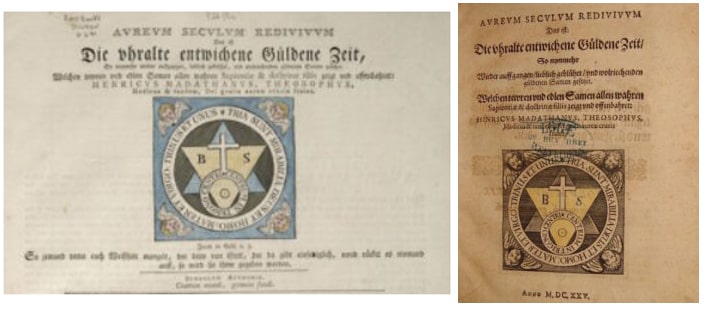
Text and emblem Aureum seculum from Geheime Figuren 1785-88 (picture left) is taken from a book first published first in 1621 and once again in 1625 (right).
The text: Ein Güldener Tractat vom philosophischen Steine, which is at the beginning of booklet 2 in the German edition, was earlier printed in 1625. Here we also find the alchemical parable, most likely also written by Henricus Madathanus. Also note that the title page here also mentions the fratres aureae crucis (the brothers of golden cross).
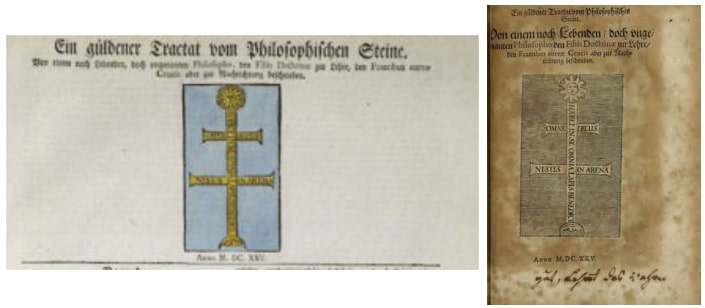
Left: From Geheime Figuren or Secret Symbols 1785-88. Right: book from 1625.
What concerns the emblems that are not part of the D.O.M.A. ms or the school of the Holy Ghost, it is clear that some of the well-known emblems of the book were already part of Friedrich Christian Ritter’s plan for publication in 1767. That means: Three worlds in one (which by the way is also the title of one of the plates in the D.O.M.A. script – so we have three worlds dwell in one twice in two different versions), the Tree of good and evil and Poculum pansophiae, amongst others. These were placed after the 28th plate of the D.O.M.A. plates. But they were taken from other sources which had been published elsewhere earler.
To start with the Poculum pansophiae (the cup of pansophy) from booklet 3 in the German edition. This was an illustration taken from the well-known Speculum sophicum rhodostauroticum (1618) by Theophilus Schweighardt Constantiens, a pen-name for Daniel Mögling.
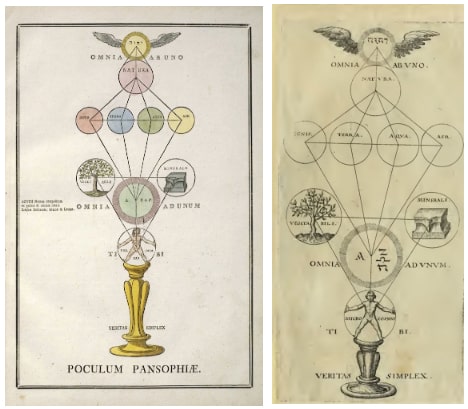
Left: Poculum Pansophiae from Geheime Figuren or Secret Symbols 1785-88. Right: The origina from Seculum sophicum Rhodostauroticum
The tree of good and evil knowledge (also booklet 3 in the German edition), is taken from Valentin Weigel (1533 –1588): Studium universale. The first printed edition is from 1618, but the picture at least shows up in the 1695 edition.
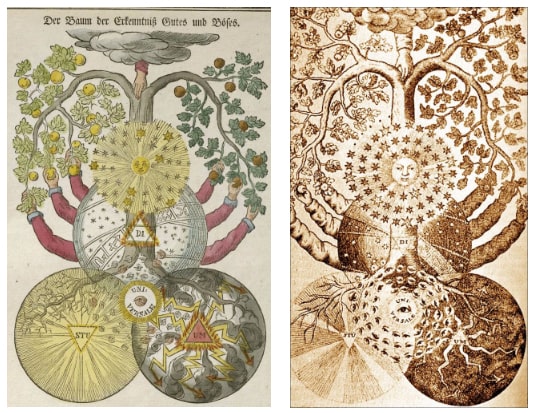
Geheime Figuren to the left, Weigels picture to the right
Within this world three worlds in each other (also booklet three in Geheime Figuren or Secret Symbols) is actually taken from Paul Kaym’s Helleleuchtender Hertzens-Spiegel (The mirror of the mystical heart). Paul Kaym was a contemporary and admirer of Jacob Boehme. This image at least shows up in an 1705 edition, if not earlier.
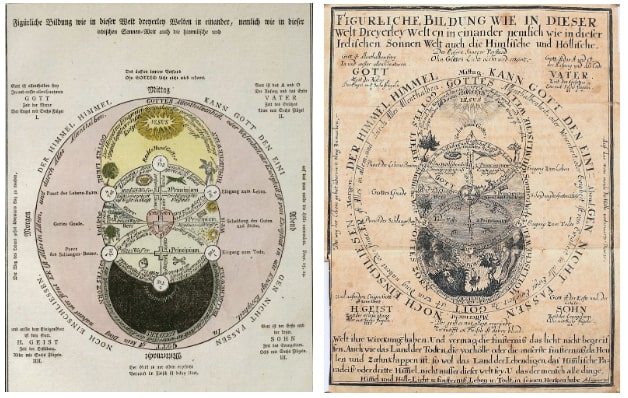
The Tabula Smaragdina from (booklet 3: Geheime Figuren) is in reality a picture AND a text taken from a book published in 1613. It is called Occulta philosophia.

Mons philosophorum in Geheime Figuren (also booklet 3) is printed already 1604 in a book called Alchymia Vera. The text that accompanies this picture in Secret Symbols Is also in entirety taken from this original publication, also called Mons philosophorum.
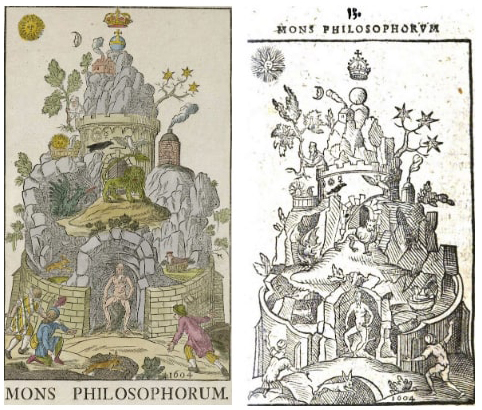
Picture from Gegeime Figuren on the left, picture from Alchymia Vera on the right
A few of Böhme-illustrations ( Gnadenwahl – Wille or Election of Grace – Will) are included directly in the emblems, but Boehmes influence is felt in many ways otherwise.
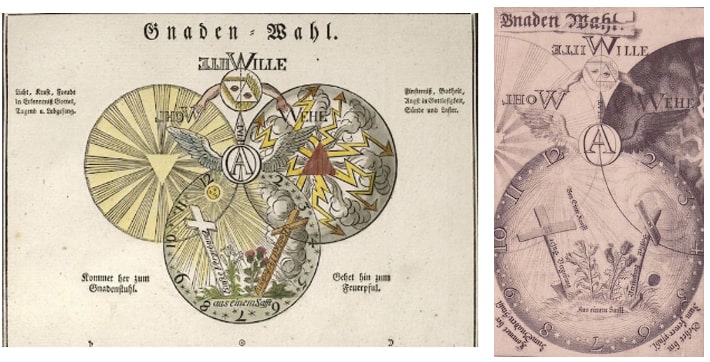
These were just a few examples that the additions are texts and emblems of old age, that they are related to alchemy, hermetism, cabbala, theosophy and the Rosicrucian tradition, so they were hardly chosen randomly for the Altona edition of 1785-88. The title: Rosicrucian symbols (or teachings) of the Rosicrucians of the 16th and 17th century is – somehow – near the truth.
Finally, it should also be emphasized that there are other colored manuscripts of something based on the D.O.M.A in which the picture of the Rosy Cross is included, the one which every brother should wear on his breast. On this cross there is written, amongst other things, frater Rosae et Aureae Crucis, that is, brother of the Rosy and Golden Cross. These manusscript also include parts of the D.O.M.A. manuscript’s emblems, beautifully colored and with a number of differences, so these are obviously not just copies of D.O.M.A.
But not all tables from D.O.M.A. are included so that these manusscripts are shorter than both D.O.M.A. and of course the Secret Symbols The tree of good and evil Knowledge is included, but in a different version than in the Geheime Figuren. The manuscripts also include some tables that do not appear in the Geheime Figuren or D.O.M.A. They seemingly are based on Tycho Brahe’s magical calender. These manuscript originate from around 1750 and are related to both the Golden Rosy Cross brothers and Freemasonry in Germany and France.
Christine Eike
____________________________________________
New readers, don’t forget to sign up to our blog to read other more interesting articles just like this. We’ll never send you marketing emails. Just a quarterly update on the most recent top post. Sign up if you love Rosicrucian reading and Pansophers!
____________________________________________
[1] A GERMAN original EDITION one can find here: http://digicoll.library.wisc.edu/cgi-bin/HistSciTech/HistSciTech-idx?type=header&id=HistSciTech.GeheimeFiguren&isize=M
[2] More information, with some pictures and sources to this new German edition can be found here: http://rosenkreuzer-lehrtafeln.de/index.php
[3] See Manly P. Halls D.O.M.A. book or Codex Rosae Crucis for instance here, a rendition made by Stephen Murtaugh: https://dokumen.tips/documents/physica-alpha-and-omega-metaphysica-and-hyperphysica-doma-codex-rosae-crucis.html
[4] Source: Cod. Guelf. 454 Nov. (J.A. Starck, Physica, Metaphysica et Hyperphysica, 18. Jh.), Herzog August Bibliothek in Wolfenbüttel. http://diglib.hab.de/mss/454-novi/start.htm?image=00007
[5] Codex in scrinio 21. Staats- und Universitätsbibliothek Hamburg http://digitalisate.sub.uni-hamburg.de/nc/detail.html?id=1901&tx_dlf%5Bid%5D=15792&tx_dlf%5Bpage%5D=2
[6] It is not quite certain what the initials D.O.M.A. stand for. They can be found in a lot of books, both books with Rosicrucian connections and others. This abbreviation can also be found on the title page of most of the books of Andreas Libavius, one as early as 1597 on alchemy. Manly P. Hall suggests that the letters are the initials of four Latin words: Deo, Optimo, Maximo, Altissimo and that they are a form of dedication to this ”best, greatest, highest God” – which would be quite in line with the pious Lutheran Libavius, who wrote on alchemy but both attacked and later was a bit more favourable to the early Rosicrucian furore in his book D.O.M.A. Wohlmeinendes Bedenken von der Fama und Confession etc., published in 1616. The publication a year earlier (an attack on the Rosicrucians) is named D.O.M.A. Analysis confessionis Fraternitatis de Rosae Cruce (1615).
[7] http://www.alchemywebsite.com/lampado.html


